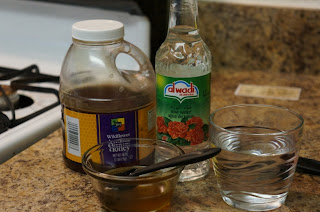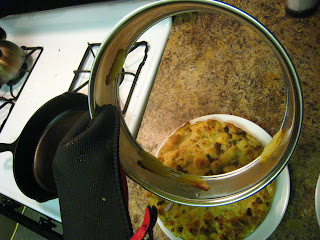It's less than a week to my first finals due date, which means that I have to be on my A-game. In regards to procrastination, that is. And since I've realized that I'm not going to get anymore actual work done tonight on badass mysterious female Restoration playwright Mary Pix, I might as well do some catching up on the cooking. And just in case you were wondering, I'm not overstating the awesomeness here. Or the mystery. We only know when she was born because we know how old she was when she got married. And we only know when she died because there was a benefit performance for her estate. And we only know that she killed all the rabid wombats in London because London is no longer plagued by wombats, rabid or otherwise.
But, uh, I was probably talking about a recipe I did. Many moons ago (well, two weeks) I decided I should return to the dessert section of Shakespeare's Kitchen and try my hand at some baking. My various cookie attempts had all turned out strangely poorly, so I thought it would be a good time to try again with 1610 Rose Cakes. Despite the name, the Rose Cakes are actually cookies and the recipe only makes about 30 of them, not over sixteen hundred. Ok, the actual reason it's called that is because the recipe is from around 1610, from the personal cookbook of one Sarah Longe.
To make sugar CakesTake a pound of butter, and wash it in rose-water, and halfe a pound of sugar, and halfe a douzen spoonefulls of thicke Cream, and the yelkes of 4 Eggs, and a little mace finely beaten, and as much fine flower as it will wett, and worke it well together then roll them out very thin, and cut them with a glasse, and pricke them very thicke with a great pin, and lay them on plates, and so bake them gently.
MISTRESS SARAH LONGE HER RECEIPT BOOKE
This is one of those recipes that I might be tempted to try from the original one day. Especially since, well, I wasn't terribly amazed by my results this time around. Not entirely sure who to blame for this one. I can sort of imagine Shakespeare trying them back in 1610. "Forsooth, Mistress Longe," he would sayeth, "these cakes seemed like a good idea at first, but alas, they were not. Verily, I am inspired to write Cymbeline."
OH! Almost forgot to mention: I picked up a new camera. My old one was a six year old point and shoot, and not exactly great at taking pictures indoors. The new one is already a million times more useful, and that's before I've actually gotten any good at using it. If nothing else, the pictures should have a lot less noise. Although you'll have to deal with me messing around with depth of field and trying to be all arty and out of focus and etc. Or at least, this is what I will tell you I was doing whenever I am forced to post a crap photo because it was all I had for an important step.
Segan's version of the Rose Cake recipe uses rose syrup instead of straight-up rose water. I didn't actually have rose syrup available, but the recipe contains a sub-recipe for a substitute: Rose water, non-rose water, and honey. It mostly tastes like honey.
Here we have Ariel just waiting to chow down on the main ingredients. Butter, mace, sugar, and some of the rose syrup. The rest is reserved for glazing later. Is glazing the right term? Brushing something syrupy onto a hot thing and letting it cool? Anyway.
Two eggs, separated and so yellow that they drained all the rest of the color from the world so they could be that much more yellow. Either that, or I discovered my favorite camera setting ever. My point-and-shoot used to do this as well, although it had the benefit that you could choose your colors as you went instead of choosing among the few pre-programmed into the camera. Ah well. Separating eggs is actually something that I'm pretty good at, and I was almost a little disappointed that the whites don't get used for anything. Because they were really, really separate.
Two cups of pastry flour lying in wait. For reasons unbeknownst to me, I purchased whole wheat pastry flour, which I guess makes my cookies healthy or something? I'm going with magically healthy.
WARNING: The images you are about to see are violent, and may disturb some viewers. That poor, poor butter. Taken from us before its time.
Here we have the results of the creaming. I know the safety section of my instruction manual says not to stick anything in the bowl while blending, but I find it so much easier to deal with this step if I use a spatula to divert butter away from the walls of the bowl and back towards the beaters.
The eggs get tossed in one at a time, which isn't actually interesting enough to warrant a picture. I took one anyway because I wanted to take more pictures, so sue me.
The butter mixture mid-eggening. My butter diversion technique is unstoppable!
Once the eggs are taken care of, flour is next, one cup at a time. I get nervous about parts of recipes that say "until just mixed" or "just incorporated." I'm always terrified that I'll get to a point where I either have to give up and have clumps of unmixed ingredients or an overmixed mush that wasn't going to cook right.
Luckily, my mush just incorporated.
Here's where things get dicey. The modern version of the recipe calls for a flower-shaped cookie press. And I read that and thought "Oh, yeah, let me grab my flower-shaped cookie press, I keep it in the cookie-press drawer between the egg-shaped and gnu-shaped cookie presses." I know that cookie presses are a thing, but not something I had lying around. Lucky for me, the recipe also says you can just drop the cookie dough by the tablespoon. If the bakers among you are already slightly skeptical about a cookie dough that is equally at home being pressed out, cut, and dropped, this is because you are wiser in the ways of cookies than I.
For those not in the know, there are (generally speaking) two main types of cookie dough. One, most commonly encountered in sugar cookies, requires rolling out (often after refrigeration) and cutting. The cookies swell a bit in the oven, but don't change their shape terribly much. The other kind, usually referred to as drop cookies, is what you get when you make chocolate chip cookies. You drop a glob of cookie dough onto a baking sheet and it puddles out into the cookies we all know and love. So when the recipe says "You can either shape this beforehand or drop it," I should have been on guard. And I should have taken a look at the original 1610 recipe before cooking. If I had, I probably would have rolled out the dough and cut it with a glass. Instead, I used a tablespoon to make lumps, expecting them to flatten out in the oven.
Here are my cookies, eagerly awaiting the closing of the oven door. Witness the majesty that is my fancy new oven thermometer! If that thing is correct, then my oven has a propensity to be about 100-150° hotter than I actually set it. Whoops. But this is good to know.
Ok, so this picture isn't all that great but I was really proud that I managed to trick the camera into focusing on the oven contents instead of on the dots on the oven door. On the other hand, you can tell fuck all about the state of the cookies, which I guess is an accurate representation of sitting through the cooking process.
One tray of cookies came out a bit more done than the other, but everything was within acceptable tolerances. Of course, since I used two different baking sheets in two different places in the oven, I have no idea how to control for the correct results. Or even which results were correct. But you can see that the cookies' only real concession to drop-cookie-style melting was that they all adjusted enough to touch the cookie sheet.
I brushed the cookies with the remaining rose syrup while they were still hot, and then waited for them to cool. Quick shoutout to Dancing Bull Wine for giving me a free bbq brush at the 2010 BBQ Battle. It's been really useful, except never for bbq. Anyway, this is the final product, and it is kind of good looking.
But not exactly what I call evenly cooked. You can see that the inside wasn't quite as done as the outer part of the cookie. Probably wouldn't have been an issue if I had rolled them out, although then I would be complaining about how quickly they burnt.
Verdict: They taste like honey? The rose doesn't come through terribly well - if I did this again, I'd use less regular water and more rose water when creating the rose syrup. And maybe spring for a cookie press so I can see how they were supposed to turn out shape- and consistency-wise. All in all, they were nothing special. Although people did keep sneaking back for more of them even after deciding they were nothing special and certainly no one needed to eat more of them. So there is that. But I chalk it up to any cookie vs. no cookie. The recipe was pretty simple, and I'd take a shot at it again except for the minor detail that there are billions of recipes I haven't tried yet and no pressing need to revisit this one.
Happy Classical Theatre Fundraising Day!


























































